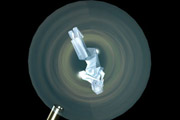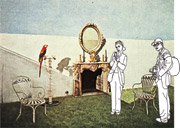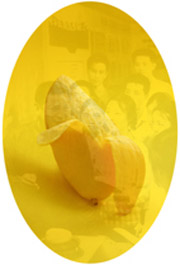On the Road to Venice or Who Speaks for Whom When a Parrot Speaks for You?
I must say, right from the start - I was not sure I wanted to curate in a Biennale. Don’t get me wrong, I’m excited by the challenge and feel honored to have this opportunity. Its just that I’m not quite sure a show like this can be curated (how’s your Chinese?). Perhaps I should explain.
From the beginning, I was interested in how Hong Kong, both literally and as a "representative" city, well, represents itself globally. Additionally, how cities, city-states, semi-states and nations show themselves to the world (and to Venice) is relevant beyond our Special Administrative Region’s borders. (remember, this is not necessarily either for...or about...Hong Kong).
It’s clear that cities create and employ representational strategies in promotion of a particular identity, accepting that this identity may not be concrete, clear or particularly successful. (Asia’s world city?) Regardless, as a city identity becomes a brand, it desires real cultural artifacts to substantiate itself. From tourism boards to architectural firms, from government departments to independent arts, city images are created and disseminated globally (and locally-collateral tourism) in vast quantities and in varying quality. Enormous amounts of time and money are spent in making our cities visible to the rest of the world (and of course to ourselves). This generates intricate networks of imaging strategies, interacting and competing for economic and cultural gain (and, not surprisingly, Hong Kong wants in on it).
Now, its not hard to imagine there would be a certain level of inferiority necessary to desire this sort of attention, and Hong Kong, in the company of many other sites, feels that inferiority (but disavows it). It feels this in a general way when it comes to Culture and, more specifically, when it comes to art and mainland-China. (we want to be art-stars too)
So, the city’s motivations are not mysterious (its a promotional / income / culture / esteem generating exercise). But, beyond (or underneath) this, it’s also about making meaning __ and from this perspective, it is both pragmatic and conventionally predictable in its imaging strategies. Yet it can also empower... it can offer the opportunity for real-world intervention into the state of a city’s culture and, importantly, influence how that culture is produced, packaged and consumed internationally (self-important?). It’s something we as artists, designers, writers and architects do all the time anyway, though usually unintentionally. (collateral representation?) However, in Hong Kong we are at a transitional moment, the time when a city first starts to create a real, international image. This context offers up this moment...a time to choose between conformity, resistance or indifference (we chose all three just to be safe).
This process is the focus of STAR FAIRY’s critique. It is the problem I posed to the artists, asking them to respond to these issues, to use it as a jumping off point (or ignore the point entirely).
I asked very simple questions: How does Hong Kong show itself to the world? What sorts of strategies does it use to say "This is Hong Kong" when it presents itself through ads, tourist promotions, cinema, design and so on?
Then, turning the questions around; why are we going to Venice? What can we say about our city in an event as multi-faceted, historic and prestigious (and as weighed down by tradition and history) as the 52nd Venice Biennale?
COLLATERAL REPRESENTATION?
STAR FAIRY sees this "representational" problem as the primary concern for Hong Kong’s participation in Venice (that and the shipping of over 50 cubic meters of work to a place with no roads and more rules than a military boot camp). Regardless, this "strategy of representation problem" became the starting point for Amy Cheung, Map office (Laurent Gutierrez + Valérie Portefaix) and Hiram To who, in one way or another, had already been addressing these issues in previous work.
This approach is especially relevant for Hong Kong’s participation as a "Collateral Event" (meaning, like collateral damage, we happened unintentionally?) as the Venice Biennale is the last of the "nationally" structured international art exhibitions. It is indiscrete and unashamed in its nationalism - and that’s not a criticism. This directness cannot be found in many other Biennales (read big international exhibitions) which have long since eschewed this nationalistic structure. However, in the process, we have shifted the same issues to the curatorial platform (read exhibition catalog), turned it a source of critique (read, well, pretty much all the big shows in the 90s) or sometimes just pretended people don’t come from anywhere anymore (read nomadic, third-spacers).
However, international exhibitions don’t have much of choice. They have to deal with these issues in the practical realities of customs, duty, air tickets, rooms and shipping logistics, if nothing else - not to mention language, translation and interpreting. This is not to reduce the complex issues of national representation to logistics or translation. (How many languages does the catalog need to be in?). So, international exhibitions frequently negotiate with many of the same issues of national representation as the Venice Biennale - just between the lines or behind the scenes (at least in Venice, we know where everybody comes from - its right there on the signs).
Even the irony (or is it a paradox?) that Hong Kong appears in Venice, separate and wholly apart from the very country in which it resides (where it "retrocessed" to-to which it was "handed over") now for the fourth time (the Biennale, not the handover), is rarely discussed or contested. Here, STAR FAIRY does attempt to address these issues, both through the complex layering of references found in all the installations and in how they reach out from Hong Kong, towards the mainland and beyond, both in their actual production (much of the works were "made in China") and in their conceptual engagement - but more on that below.
So, we set out to question this process, where a city seeks fame, cultural cach?and framed it in the challenging Venice Biennale context purposefully engaging with the various strategies a city might use to represent itself. Each artist then planned their own trajectories and responses, bringing three distinct (read contradictory) perspectives to the issues.
STAR FAIRY offers some playful and engaging responses to these questions (what were those questions again?). Amy Cheung’s Devil’s Advocate connects with these representational problems through references to carnival rides, alienation and, as in many of her previous works, the materiality of the work. Producing a large scale freezer room enclosing a macabre, elegant Ferris-wheel type structure, Cheung’s work turns the vertiginous experiences of carnival rides on its head. With glass enclosed, frozen human figures endlessly looping, the work closes off any interaction with the ride. As viewers, we are both literally and metaphorically frozen, as the ambient temperature within the room barely rises above 0 degrees Celsius. This is a darkly critical and playful approach. It transforms (perverts) the position of the player, rider or passenger. Left to watch and shiver, in a space that relieves the heat, we see the commodified consumer caught in a loop...frozen, cool - an intense contrast to the heat outside, allowing a simple empathy through a seductive use of the cold.
COLLATERAL RECLAMATION
Oppositionally, Map office’s Concrete Jungle / The Parrot’s Tale, presents a large-scale installation which addresses the representation of Hong Kong in a much more direct fashion (sort of). Beginning with a steamy, mist-filled island, roughly in the shape of Hong Kong Island, covered in oyster shells and inhabited by fake parrots, the work problematizes the act of representation itself. As the parrots pepper the viewer with critical questions (parrots never lie) there is a turning in on itself, an interrogation of why we are in Venice in the first place, questioning our right and ability to "speak" for Hong Kong.
Map office is also interested in how Hong Kong’s strategies of representation relate to Mainland China, responding to the issues raised above. One aspect of their work is a Personal Island, a one-meter square monument to the 10th anniversary of Hong Kong’s "retrocession" to China. This monument will be moved to the China pavilion at some point during the Biennale preview period - a "personal", private piece of space - a gift to China (a different kind of reclamation, speaking to our city’s long-term obsession with [re]claiming water land). Connected to this are the oyster shells covering the island, a recurring motif in Map office’s work and from a large oyster farm in the north of Hong Kong. These particular shells are thrown out after the meat is removed, each adding to acres of oyster fill, reclaiming land by accident (Collateral reclamation?) referring to waste, reuse, recycling and ownership.
Hiram To’s complex installation I Love You More Than My Own Death weaves multi-layered references to displays of magic, game shows, China and contemporary art into Hong Kong’s fascinating relationship with fame. With references to the early 20th century magicians Chung Ling Soo and Ching Ling Foo, one a "real" Chinese magician, the other an American dressed as Chinese, To’s work pulls at the edges of meaning (rips it to shreds may be more accurate). Christopher Priest’s novel The Prestige is a subtle but formative structure, dividing the work into "The Pledge", "The Turn" and "The Prestige", the three crucial parts of a magic trick. On top of this is a direct reference to the 1980s curator Christian Leigh and his infamous Venice Biennale show, where he reportedly ran out on the bills and disappeared...only to reemerge as an avant-garde film director a few years later (see C.S. Leigh’s Process for the longest suicide scene ever). These magicians and curators who transform and/or deny their identities become critical components of To’s installation.(Leigh was a fashion designer before a curator)
It’s this fluidity of meaning, this undoing (exploiting) of representation that connects to the overall premise of the show. Through its overly complex layering of meaning, diffusing and deferring, we exchange direct reference for a chasing of endless chains of relationships, narratives and fruits (did I mention Mao loved mangos?), To seems to at once seduce through sheer elegance and deter through density.
STAR FAIRY does not provide answers (STAR FAIRY is the answer?). But it does present articulate, critical responses to important questions of how meaning is generated through our representational strategies, how we show our cities to the world - and how we see ourselves within these processes.
Norman Ford (and friend)
NORMAN FORD
Ford has been an image-maker and educator for over 20 years. He has held numerous group and solo exhibitions and screenings in places such as Hong Kong, Bangkok, Macau, Vienna, Seoul, and Toronto. Producing photographs, video, multi-media, writing, editing and research in Hong Kong since 1994, he has published on photography and various media and is an art critic for the South China Morning Post and other publications. Ford continues to teach multi-media, visual cultural studies at the School of Design, the Hong Kong Polytechnic University.



